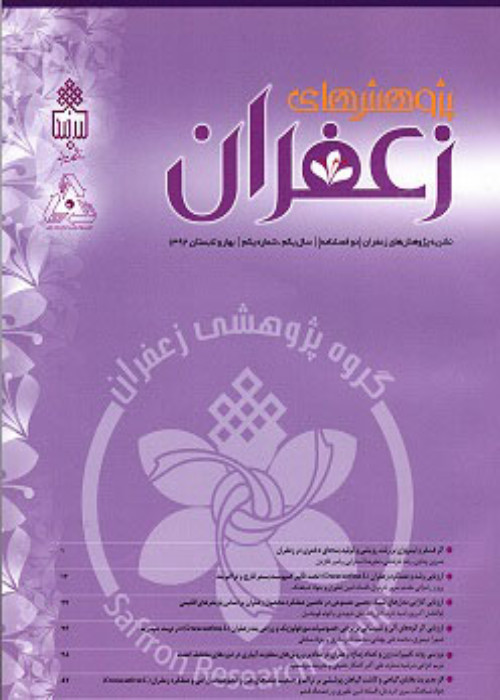Comparison of Flowering and Color Parameters of Saffron Stigma Obtained from Hydroponic and Open-Field Production Systems
Author(s):
Article Type:
Research/Original Article (بدون رتبه معتبر)
Abstract:
Introduction
The common method of traditional saffron production is its production under open-field conditions. Recently, due to climate change outcomes attention has been paid to its production under controlled conditions (hydroponic and aeroponics). In the last two decades, decrease in precipitation, increase in temperature during flower initiation phase and consequently the abortion of some initiated flowers, delay in supplying the proper temperature for flower emergence in autumn, poor soils quality which renders difficulty the flower emergence; have led to the decline in the flowering capacity of saffron in several countries under natural conditions, progressively. Accordingly, its hydroponic production could represent a possible solution for reducing the above-mentioned problems, due to the lack of soil, the proper temperature levels, and providing appropriate water availability in this production system (Behdani & Fallahi, 2015; Aghhavani-Shajari et al., 2021). In addition, under open-field condition, the flowering period of saffron lasts for about three weeks, and during this period of time, high labor is required. To solve this problem, it is possible to extend the corms pseudo-dormancy stage and the flowering phase by using the hydroponic systems, with a controlled environment. In saffron hydroponic planting systems, the amount of water consumption is reduced considerably which is important in dry regions. In addition, flower harvesting in hydroponic system is faster, cheaper, and cleaner, because environmental factors such as wind, dust, and frost, have no effect on flowers (Behdani & Fallahi, 2015; Aghhavani-Shajari et al., 2021; Fallahi et al., 2021a). However, it is necessary to compare the two systems of open-field and hydroponics in terms of the amount of flowering and the quality of the produced stigma. Materials and Methods
To compare the effect of saffron corm planting systems (including 1- under controlled environment (hydroponic) and, 2- open-field environment), on flowering indices and stigma color parameters (Hunter lab color scale), an experiment was conducted in the research field and horticultural physiology laboratory of Faculty of Agriculture, University of Birjand, during 2019, with four replications. In open-field treatment, the corms were planted in soil at a depth of 10 cm and density of 100 corms per m2, while in the hydroponic system corms were planted in trays (30×40 cm, 100 corms per tray) and were transferred to incubator (temperature: 15 oC, relative humidity: 75%, 8 hours light, 16 hours darkness). In this experiment, the traits of flower number, flowering rate, flower yield, mean flower weight, flower length, style length, stigma length, dry yield of stigma and petal, anther yield, and Hunter's color indices including brightness (L), redness (a) and yellowness (b) of saffron stigma were measured. The two planting systems were compared using t-student test, by SAS, 9.2. Results and Discussion
The results of analysis of variance showed that there was a significant different between two experimental treatments, in terms of the most studied traits. Based on the mean comparison results, there was no difference between production systems for the number and yield of flowers. However, the maximum flowering rate (5.82 flowers day-1) and the mean flower weight (0.34 g) were obtained in the hydroponics system. Also, planting corms under controlled conditions resulted in the maximum length of flower, style and stigma (7.38, 4.40 and 2.49 cm, respectively). In addition, the highest dry yield of saffron stigma was obtained in the controlled environment, so that this treatment was superior by almost 14% compared to the open-field environment. This finding is similar to those reported previously by Maggio et al., (2006), Aghhavani-Shajar et al., (2021) and Khan et al., (2022). The comparison of the color parameters between the two studied treatments showed that the maximum brightness (L) and redness (a) of the stigma (57.52 and 15.41, respectively) were observed in the hydroponic system. In a similar study, it was reported that stigmas obtained from soil less production system had higher L and crocin values, while safranal content was significantly lower in comparison to traditional production system (open-field), which means that stigma produced under open-field was some darker in appearance but had a higher aroma (Aghhavani-shajari et al., 2021). Conclusion
In general, corm planting in a controlled environment increased stigma yield and improved partially stigma colorimetric parameters.Keywords:
Language:
Persian
Published:
Journal of Saffron Research, Volume:11 Issue: 1, 2023
Pages:
94 to 107
magiran.com/p2611983
دانلود و مطالعه متن این مقاله با یکی از روشهای زیر امکان پذیر است:
اشتراک شخصی
با عضویت و پرداخت آنلاین حق اشتراک یکساله به مبلغ 1,390,000ريال میتوانید 70 عنوان مطلب دانلود کنید!
اشتراک سازمانی
به کتابخانه دانشگاه یا محل کار خود پیشنهاد کنید تا اشتراک سازمانی این پایگاه را برای دسترسی نامحدود همه کاربران به متن مطالب تهیه نمایند!
توجه!
- حق عضویت دریافتی صرف حمایت از نشریات عضو و نگهداری، تکمیل و توسعه مگیران میشود.
- پرداخت حق اشتراک و دانلود مقالات اجازه بازنشر آن در سایر رسانههای چاپی و دیجیتال را به کاربر نمیدهد.
In order to view content subscription is required
Personal subscription
Subscribe magiran.com for 70 € euros via PayPal and download 70 articles during a year.
Organization subscription
Please contact us to subscribe your university or library for unlimited access!



